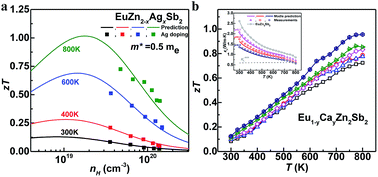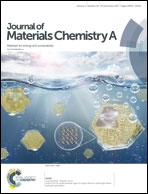Single parabolic band transport in p-type EuZn2Sb2 thermoelectrics†
Abstract
Zintl compounds are usually rich in composition and thus enable a large degree of manipulation in both electronic and phononic properties for potential thermoelectric applications. This is typified by the AB2C2 compounds (A = Eu, Yb, Ba, Ca; B = Zn, Cd, Mg and C = As, Sb, Bi) that have attracted extensive attention. Among this class of compounds, a few existing works indicate that the high thermoelectric performance in p-type EuZn2Sb2 relies on its relatively high mobility and the reported figures of merit are scattered. This has motivated this study to focus on the thermoelectric transport properties of p-EuZn2−xAgxSb2 (Ag-doped) in a broad carrier concentration range (3.5–14 × 1019 cm−3), which reveals a single parabolic band (SPB) behavior in this material and enables insights into the fundamental material parameters determining the thermoelectric performance. This finding has guided a further enhancement to be achieved by a reduction in the lattice thermal conductivity, which is realized by a strong phonon scattering through the Ca/Eu isovalent substitutional defects. The achieved peak figure of merit, zT, was as high as unity, demonstrating EuZn2Sb2 as a promising thermoelectric material.



 Please wait while we load your content...
Please wait while we load your content...